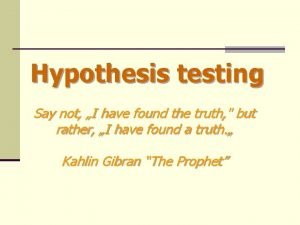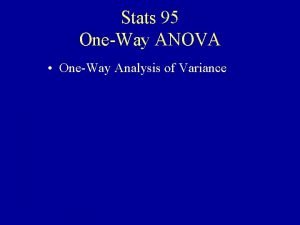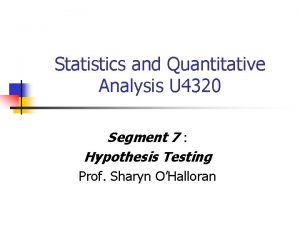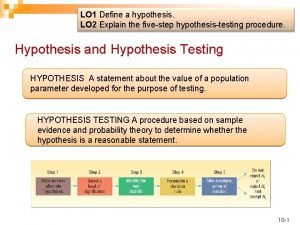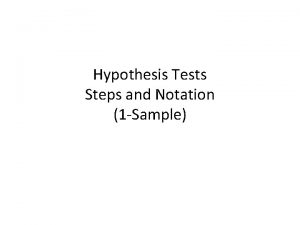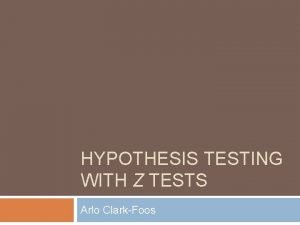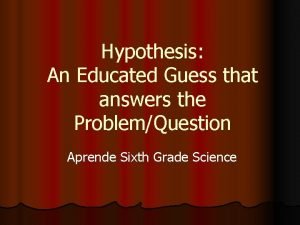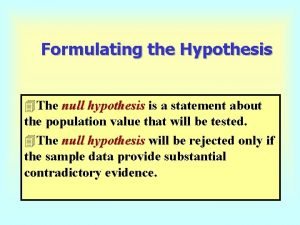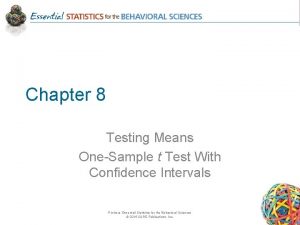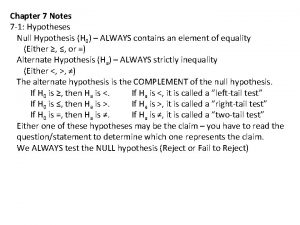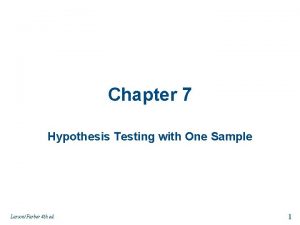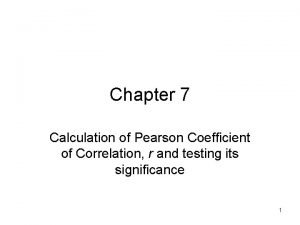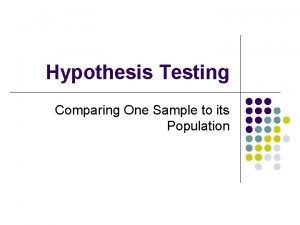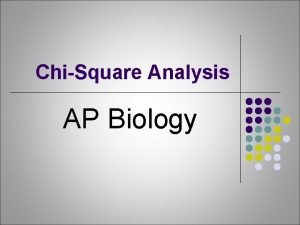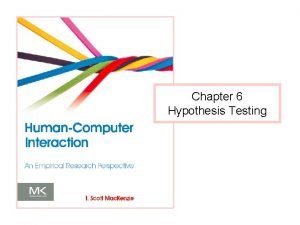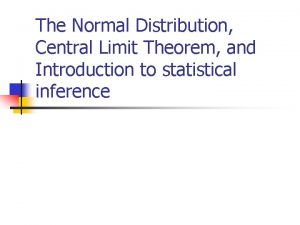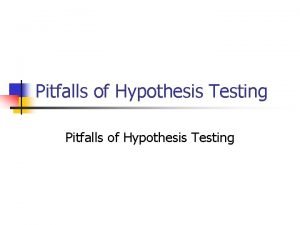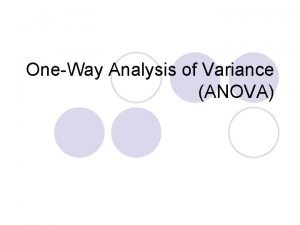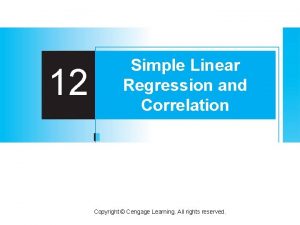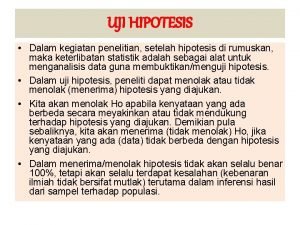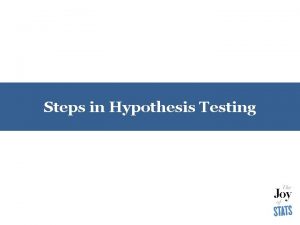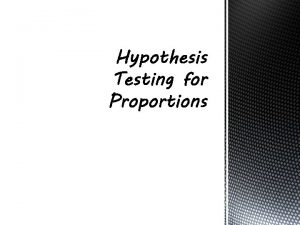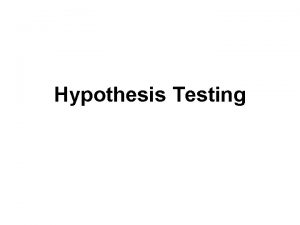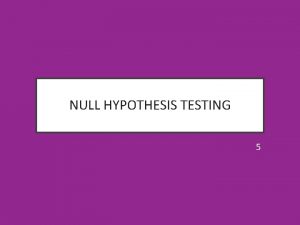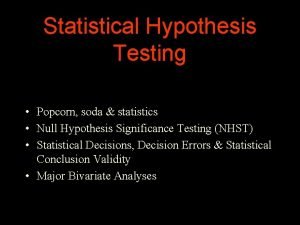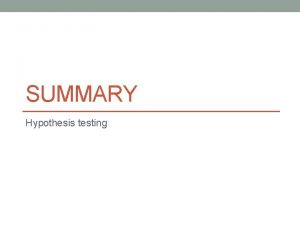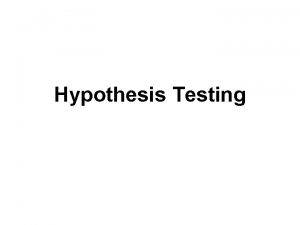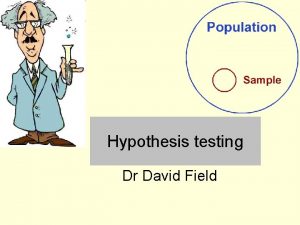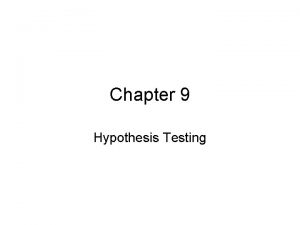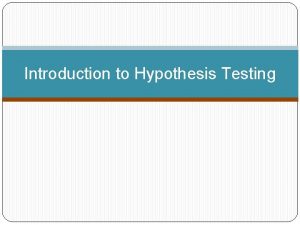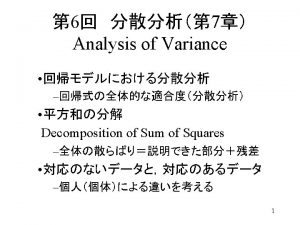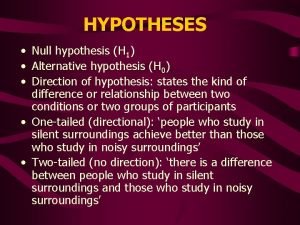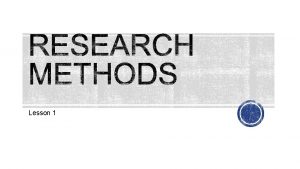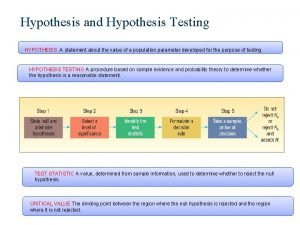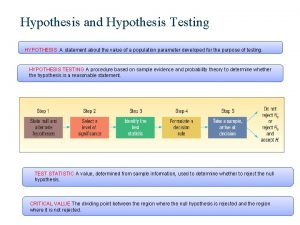Hypothesis testing Some general concepts Null hypothesis H



























- Slides: 27

Hypothesis testing Some general concepts: Null hypothesis H 0 A statement we “wish” to refute Alternative hypotesis H 1 The whole or part of the complement of H 0 Common case: The statement is about an unknown parameter, H 0 : H 1: – ( ) where is a well-defined subset of the parameter space

Simple hypothesis: (or – ) contains only one point (one single value) Composite hypothesis: The opposite of simple hypothesis Critical region (Rejection region) A subset C of the sample space for the random sample X = (X 1, … , Xn ) such that we reject H 0 if X C (and accept (better phrase: do not reject ) H 0 otherwise ). The complement of C, i. e. C will be referred to as the acceptance region C is usually defined in terms of a statistic, T(X) , called the test statistic

Simple null and alternative hypotheses Errors in hypothesis testing: Type I error Rejecting a true H 0 Type II error Accepting a false H 0 Significance level The probability of Type I error Also referred to as the size of the test or the risk level Risk of Type II error The probability of Type II error Power The probability of rejecting a false H 0 , i. e. the probability of the complement of Type II error = 1 –

Writing it more “mathematically”: Classical approach: Fix and then find a test that makes desirably small A low value of does not imply a low value of , rather the contrary Most powerful test A test which minimizes for a fixed value of is called a most powerful test (or best test) of size

Neyman-Pearson lemma x = (x 1, … , xn ) a random sample from a distribution with p. d. f. f (x; ) We wish to test H 0 : = 0 (simple hypothesis) versus H 1 : = 1 (simple hypothesis) The the most powerful test of size has a critical region of the form where A is some non-negative constant. Proof: Se the course book Note! Both hypothesis are simple

Example:


How to find B ? If 1 > 0 then B must satisfy

If the sample x comes from a distribution belonging to the oneparameter exponential family:

“Pure significance tests” Assume we wish to test H 0: = 0 with a test of size Test statistic T(x) is observed to the value t Case 1: H 1 : > 0 The P-value is defined as Pr(T(x) t | H 0 ) Case 2: H 1 : < 0 The P-value is defined as Pr(T(x) t | H 0 ) If the P-value is less than H 0 is rejected

Case 3: H 1 : 0 The P-value is defined as the probability that T(x) is as extreme as the observed value, including that it can be extreme in two directions from H 0 In general: Consider we just have a null hypothesis, H 0, that could specify • the value of a parameter (like above) • a particular distribution • independence between two or more variables • … Important is that H 0 specifies something under which calculations are feasible Given a test statistic T = t the P-value is defined as Pr (T is as extreme as t | H 0 )

Uniformly most powerful tests (UMP) Generalizations of some concepts to composite (null and) alternative hypotheses: H 0 : H 1: – ( ) Power function: Size:

A test of size is said to be uniformly most powerful (UMP) if If H 0 is simple but H 1 is composite and we have found a best test (Neyman-Pearson) for H 0 vs. H 1’: = 1 where 1 – , then if this best takes the same form for all 1 – , the test is UMP. Univariate cases: H 0: = 0 vs. H 1: > 0 (or H 1: < 0 ) usually UMP test is found H 0: = 0 vs. H 1: 0 usually UMP test is not found

Unbiased test: A test is said to be unbiased if ( ) for all – Similar test: A test is said to be similar if ( ) = for all Invariant test: Assume that the hypotheses of a test are unchanged if a transformation of sample data is applied. If the critical region is not changed by this transformation, the test is said to be invariant. Consistent test: If a test depends on the sample size n such that ( ) = n ( ). If limn n ( ) = 1 the test is said to be consistent. Efficiency: Two test of the pair of simple hypotheses H 0 and H 1. If n 1 and n 2 are the minimum sample sizes for test 1 and 2 resp. to achieve size and power , then the relative efficiency of test 1 vs. test 2 is defined as n 2 / n 1

(Maximum) Likelihood Ratio Tests Consider again that we wish to test H 0 : H 1: – ( ) The Maximum Likelihood Ratio Test (MLRT) is defined as rejecting H 0 if • 0 1 • For simple H 0, gives a UMP test • MLRT is asymptotically most powerful unbiased • MLRT is asymptotically similar • MLRT is asymptotically efficient

If H 0 is simple, i. e. H 0: = 0 the MLRT is simplified to Example

Sampling distribution of Sometimes has a well-defined sampling distribution: e. g. A can be shown to be an ordinary t-test when the sample is from the normal distribution with unknown variance and H 0 : = 0 Often, this is not the case. Asymptotic result: Under H 0 it can be shown that – 2 ln is asymptotically 2 -distributed with d degrees of freedom, where d is the difference in estimated parameters (including “nuisance” parameters) between

Example Exp ( ) cont.

Score tests

Wald tests Score and Wald tests are particularly used in Generalized Linear Models

Confidence sets and confidence intervals Definition: Let x be a random sample from a distribution with p. d. f. f (x ; ) where is an unknown parameter with parameter space , i. e. . If SX is a subset of , depending on X such that then SX is said to be a confidence set for with confidence coeffcient (level) 1 – For a one-dimensional parameter we rather refer to this set as a confidence interval

Pivotal quantities A pivotal quantity is a function g of the unknown parameter and the observations in the sample, i. e. g = g (x ; ) whose distribution is known and independent of . Examples:

To obtain a confidence set from a pivotal quantity we write a probability statement as (1) For a one-dimensional and g monotonic, the probability statement can be re-written as where now the limits are random variables, and the resulting observed confidence interval becomes For a k-dimensional the transformation of (1) to a confidence set is more complicated but feasible.

In particular, a point estimator of is often used to construct the pivotal quantity. Example:


Using the asymptotic normality of MLE: s One-dimensional parameter : k-dimensional parameter :

Construction of confidence intervals from hypothesis tests: Assume a test of H 0: = 0 vs. H 1: 0 with critical region C( 0 ). Then a confidence set for with confidence coefficient 1 – is
 Hypothesis in quantitative research
Hypothesis in quantitative research Alternative hypothesis
Alternative hypothesis Accept or reject hypothesis
Accept or reject hypothesis Create a meme about concepts in hypothesis testing
Create a meme about concepts in hypothesis testing One way anova null hypothesis
One way anova null hypothesis How to find t critical value
How to find t critical value Research hypothesis
Research hypothesis One way two way anova
One way two way anova Standard deviation null hypothesis
Standard deviation null hypothesis Hypothesis paragraph example
Hypothesis paragraph example Test assumptions
Test assumptions Is hypothesis an educated guess
Is hypothesis an educated guess Null hypothesis
Null hypothesis Chi square critical value table
Chi square critical value table One sample t test null hypothesis
One sample t test null hypothesis Examples of null hypothesis
Examples of null hypothesis Null hypothesis symbol
Null hypothesis symbol Formula for ssxx
Formula for ssxx What's a null hypothesis in psychology
What's a null hypothesis in psychology Hypothesis test equation
Hypothesis test equation Ap biology
Ap biology Mann whitney null hypothesis
Mann whitney null hypothesis What is harmful dysfunction
What is harmful dysfunction Define null hypothesis
Define null hypothesis Steps in hypothesis testing ppt
Steps in hypothesis testing ppt How to report anova results
How to report anova results Null hypothesis for linear regression
Null hypothesis for linear regression Contoh ho dan ha
Contoh ho dan ha



